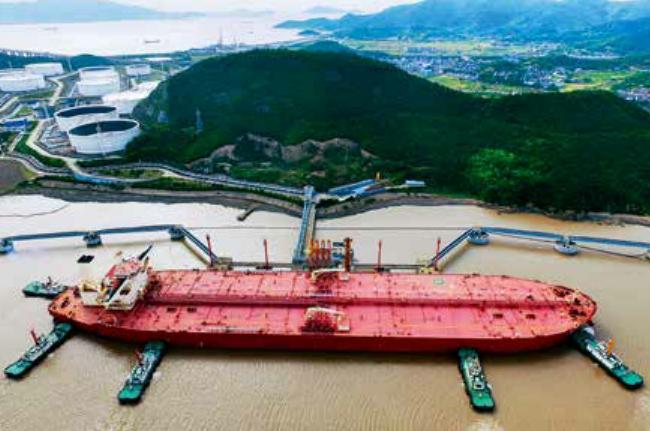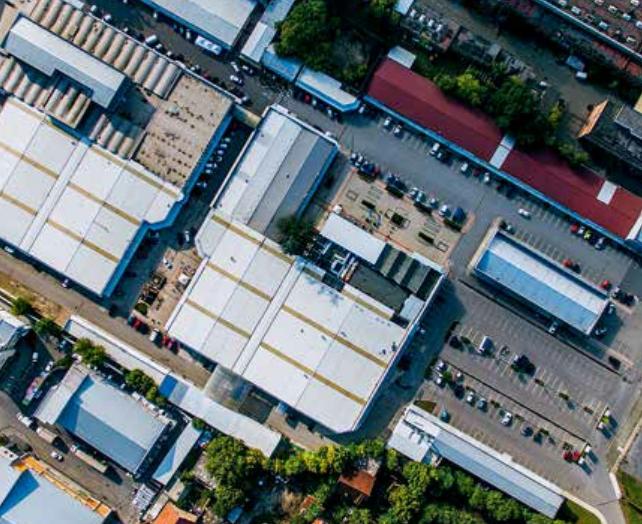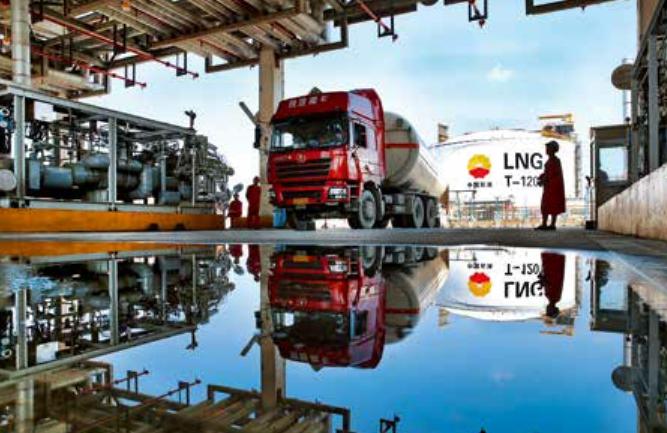Belt and Road Initiative New Avenues for Global Cooperation
by China Pictorial



Since the international finan- cial crisis in 2008, the world economy has seen a downturn. Major Western countries have deployed various measures to boost their economies, but growth is still weak. At the same time, societal problems have swelled over the years to the point of eruption, and dissatisfaction has spread across the globe. A wave of populism is rising in many countries. Under these circumstances, the Chinese government launched the Belt and Road Initiative (BRI), with an aim to promote policy coordination, connectivity of infrastructure, unimpeded trade, financial integration and closer people-to-people ties under the principles of “extensive consultation, joint contribution and shared benefits.” Through seizing new ideas, exploring new models and coping with new challenges, China is pursuing mutual benefits and win-win results with an increasing number of countries.
Contributing a Chinese Solution
Glaring signals have shown that the liberal model of world development has gone wrong. In the process of globalization, the liberal model has gradually gained too much advantage. In order to increase competitiveness, capital gains seek to maximize profits through every possible means. The easing of the conditions for capital output has enabled this model to gradually spread through the worlds major economies and developing countries alike. In the process, a remarkable phenomenon to emerge alongside rapid economic growth has been serious social divisions as well as the intensification of social problems. Today, the ceiling of this model seems to have been reached. In these circumstances, countries and regions around the world are looking for ways out. The worlds major powers are seeking to formulate new rules. Mechanisms like the Trans-Pacific Partnership (TPP) and the Transatlantic Trade and Investment Partnership (TTIP) have emerged, but their operation is facing difficulties.
In 2013, Chinese President Xi Jinping proposed the BRI, an initiative for international cooperation that consists of the Silk Road Economic Belt and the 21st-Century Maritime Silk Road. The initiative has pioneered a new mode of cooperation, activated various cooperation mechanisms, created numerous records in cooperation and promoted regional economic development. At the same time, amid the changing world situation and the new difficulties and obstacles hindering globalization, the BRI has become the Chinese solution to global governance.
Over the past more than five years since it was proposed, the BRI has not only become an important driver of pragmatic cooperation, but also a significant player in international relations. Promising early results have also been achieved in various fields under the initiative. These achievements are seen not only in Chinas development, but also in the development of other participating countries and the expansion of international cooperation. So far, China has signed BRI cooperation agreements with 80 countries. From 2013 to 2018, Chinas trade of goods with countries participating in the BRI exceeded US$5 trillion, and Chinas investment in those countries hit US$60 billion. These achievements have promoted cooperation among countries involved and promoted the social and economic development of participating countries. At the same time, the BRI has promoted the connectivity of development strategies, national interests and investment policies among participating countries. Through such connectivity, the initiative has created tremendous development potential and momentum as well as huge benefits.
Global BRI
After the BRI was first launched, Central Asian countries responded first. Central Asian countries benefited considerably from the ancient Silk Road and have a strong desire to revive the Silk Road. Thus, they are naturally in favor of the BRI. Located in the heart of Eurasia, Central Asia has an advantage of geographical centrality, but the regions remoteness in relation to the vast continent makes participating in the international division of labor more difficult. Take the development of the global textile industry as an example: Although Central Asia is rich in human resources and cotton, the center of gravity of the global textile industry has bypassed this region as it moved from Europe and America to Japan and South Korea and then to China before reaching Southeast and South Asian countries such as Vietnam and Bangladesh. Obviously, geographical restrictions and traffic inconvenience are important factors hindering the regions development. However, the BRI has repositioned Central Asias standing in the global economy, bringing the region from the edge of the world to the center and generating unprecedented historic opportunities for Central Asian countries to participate more deeply in the global division of labor.
Over the past five years, Central Asian countries have gained a clearer view on the BRI, with early goodwill evolving into multi-faceted supportive action. Signing memorandums of understanding (MoUs) and joint statements may have only indicated willingness to cooperate under the framework of the BRI, but a detailed roadmap marks a new phase of cooperation rising from theory to pragmatism. Cooperation between China and some Central Asian countries has already reached this point. Although the construction of the Belt and Road may encounter various problems, further deepening cooperation has been the general trend, considering the high-degree connectivity of strategic interests of participating countries.
West Asia is home to most of the Arab countries as well as Iran, Turkey and Israel. Since the BRI was proposed, countries in West Asia have paid great attention and responded positively. By the end of 2018, China had established comprehensive strategic partnerships with three West Asian countries, strategic partnerships with five West Asian countries, and signed BRI MoUs with three West Asian countries. In addition, nine West Asian countries are founding members of the Asian Infrastructure Investment Bank.
At the beginning of this century, cooperation between China and West Asian countries focused on the field of energy. At the 2014 ministerial meeting of the ChinaArab States Cooperation Forum in Beijing, President Xi Jinping proposed the “1+2+3” cooperation framework with “energy cooperation as the main axis, infrastructure construction and trade and investment facilitation as the two wings, and three high-tech fields of nuclear energy, space satellite and new energy as the breakthroughs.”Through further promotion of the BRI, cooperation between China and Western Asian countries has expanded to myriad fields including security, healthcare and culture. A comprehensive framework of cooperation has taken shape.
South Asia is located at the intersection of the sea and land routes under the BRI, making it an important area and its countries important partners for the construction of the Belt and Road. The BRI has been widely welcomed by South Asian countries, and most of them have signed bilateral agreements with China to cooperate under the framework of the initiative. A flagship project for the Belt and Road, the China-Pakistan Economic Corridor is progressing smoothly, and the China-Nepal Economic Corridor and the Bangladesh-China-IndiaMyanmar Economic Corridor are also advancing.
Africa was an important foothold of the ancient Maritime Silk Road. China and Africa are working hand in hand to promote the construction of the Belt and Road, becoming a highlight of international cooperation under the framework of the BRI. Over time, Africa has evolved into a key partner and an important parti cipant of the BRI. Represented by construction of the African road network, achievements made by China and Africa in building the Belt and Road have been regarded as a highlight of international cooperation, and the African leg of Belt and Road has been outstanding. Already, China has helped more than 2,000 African villages install satellite TV equipment. The project will eventually benefit 10,112 villages in 25 African countries. The spirit of people-to-people exchange has been well implemented in China-Africa cooperation.
Although the Nordic countries are far from China, they are also actively exploring how to promote their own development through the BRI. The five Nordic countries are among the founding members of the Asian Infrastructure Investment Bank, and three-dimensional transportation between China and the Nordic countries has taken shape. A freight rail line between Xian and Kouvola was launched, Chinas freighters regularly stop at the Finnish port, and Finnair started offering six different direct flights to China. The Nordic countries, which are facing various development problems, hope to gain momentum through the BRI as they look for new kinetic energy for their own economic development.
Diversified Cooperation
Over the past more than five years since the BRI was launched, China has cooperated with other participating countries in various ways to ensure that trade cooperation, production capacity cooperation, and cooperation in industrial parks gradually improved. From the perspective of trade volume, Chinas exports to countries participating in the BRI have accounted for a rising proportion of its total exports. Imports from those countries were affected by fluctuations in commodity prices. From the perspective of trade structure, inter-industry trade is the main structural feature of Chinas trade with countries participating in the BRI, but intra-industry trade dominates Chinas trade with Southeast Asian countries, manifesting that the level of intra-industry division of labor is relatively high. Relatively speaking, despite the high level of industrialization in Central and Eastern European countries, the characteristics of those countriesinter-industry trade with China indicate that there is still a lack of intra-industry division of labor between China and those countries.
At the same time, China has made positive progress in production capacity cooperation with countries participating in the BRI: The scale of production capacity cooperation has continued to expand, and several major landmark projects have been launched. Overseas economic and trade cooperation zones have developed rapidly, fields of cooperation have continued to expand, and participating entities have become increasingly diversified. Domestic enterprises in the eastern part of China are the main force to “go global,” and potential in the countrys central and western regions is also relatively large. Production capacity cooperation under the BRI and China-Central and Eastern European countries(16+1) and China-Africa production capacity cooperation form a coordinated pattern of development. The development of economic and trade cooperation zones provides an important platform to promote the construction of the Belt and Road and international industrial capacity cooperation. By the end of 2017, China had established 75 overseas cooperation zones with countries participating in the BRI. Most of them are located in Southeast Asia, Russia, and Central and Eastern Europe.
Among those overseas cooperation zones, 20 have been built at certain scale. In 2017, the total investment of Chinese-funded enterprises in those 20 cooperation zones exceeded US$5.8 billion, with a total output worth more than US$11 billion, providing jobs for more than 110,000 local people. Construction of those cooperation zones has created a new method of overseas investment cooperation, explored and established a relatively mature model and become an important platform of international cooperation in production capacity and equipment manufacturing. Moreover, it has played an important role in promoting the development of bilateral relations.
The promising outcomes of the BRI over the past more than five years have encouraged enterprises and other entities that have actively participated. Like all major processes and programs, more than five years of practice have also highlighted the complexities and challenges involved in building the Belt and Road. Some countries still harbor misunderstandings about the BRI and worry that China has geopolitical aims. Those who have participated in the initiative are mostly developing countries with complex social environments and limited economic scales. The economic policies and business environments in different countries also vary sharply. Non-traditional security issues such as political turmoil, terrorism, separatism and transnational crimes have also threatened the construction of the Belt and Road.
Under these circumstances, a wide array of countries and regions jointly responding to the challenges is the only way out. The construction of the Belt and Road is not only about pragmatic cooperation, but also about security cooperation. It will not only produce mutual benefits and win-win results economically, but also solidify regional stability.
